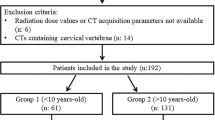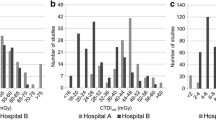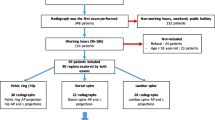Abstract
Objectives
To compare the effects of different arm positions on dose exposure and image quality (IQ) in cervical spine CT after trauma in different patient groups.
Methods
Patients in standard (STD = 126) and in swimmer’s position (SWIM = 254) were included. Body mass index (BMI subgroup 1 = underweight to subgroup 4 = obese), anterior–posterior diameter (AP), left–right diameter (LR), area of an ellipse (AoE) and angle between the humeral heads (optimal STD < 3°, optimal SWIM > 10°) were used as grouping criteria. Computed tomography dose index (CTDI) was documented. Two radiologists rated the IQ at three levels (CV1/2, CV4/5, CV7/T1) using a semi-quantitative scale (0 = not diagnostic, 1 = diagnostic with limitations, 2 = diagnostic without limitations). The Mann–Whitney U test correlations of grouping criteria with dose effects and intra-class correlation (ICC) were calculated.
Results
ICC was 0.87. BMI grouping showed the strongest correlation with dose effects: CTDI of optimal STD versus optimal SWIM positioning was 3.17 mGy versus 2.46 mGy (subgroup 1), 5.47 mGy versus 3.97 mGy (subgroup 2), 7.35 mGy versus 5.96 mGy (subgroup 3) and 8.71 mGy versus 8.18 mGy (subgroup 4). Mean IQ at CV7/T1 was 1.65 versus 1.23 (subgroup 1), 1.27 versus 1.46 (subgroup 2), 1.06 versus 1.46 (subgroup 3), 0.79 versus 1.5 (subgroup 4).
Conclusion
Patients with a BMI > 20 kg/m2 benefited from both potential dose reduction and improved image quality at the critical cervicothoracic junction when swimmer’s position was used.
Key Points
• BMI is a useful metric for personalized optimization in CT for the c-spine.
• Using swimmer’s position, patients can benefit from dose reduction.
• In some patients a superior image quality can be achieved with swimmer’s position.
• For swimmer’s positioning an angle of more than 10° is optimal.





Similar content being viewed by others
References
Larson DB, Johnson LW, Schnell BM, Salisbury SR, Forman HP (2011) National trends in CT use in the emergency department: 1995–2007. Radiology 258:164–173
American College of Radiology (2009). ACR appropriateness criteria: suspected spine trauma. http://www.acr.org. Accessed 28 June 2013
Blackmore CC, Ramsey SD, Mann FA, Deyo RA (1999) Cervical spine screening with CT in trauma patients: a cost-effectiveness analysis. Radiology 212:117–125
Fleischmann D, Boas FE (2011) Computed tomography–old ideas and new technology. Eur Radiol 21:510–517
Geyer LL, Korner M, Hempel R et al (2013) Evaluation of a dedicated MDCT protocol using iterative image reconstruction after cervical spine trauma. Clin Radiol 68:e391–396
Kropil P, Cohnen M, Andersen K, Heinen W, Stegmann V, Modder U (2010) Image quality in multidetector CT of paranasal sinuses: potential of dose reduction using an adaptive post-processing filter. Rofo 182:973–978
Kropil P, Lanzman RS, Walther C et al (2010) Dose reduction and image quality in MDCT of the upper abdomen: potential of an adaptive post-processing filter. Rofo 182:248–253
Thibault JB, Sauer KD, Bouman CA, Hsieh J (2007) A three-dimensional statistical approach to improved image quality for multislice helical CT. Med Phys 34:4526–4544
McCollough CH, Bruesewitz MR, Kofler JM Jr (2006) CT dose reduction and dose management tools: overview of available options. Radiographics 26:503–512
Baum U, Anders K, Steinbichler G et al (2004) Improvement of image quality of multislice spiral CT scans of the head and neck region using a raw data-based multidimensional adaptive filtering (MAF) technique. Eur Radiol 14:1873–1881
Mulkens TH, Marchal P, Daineffe S et al (2007) Comparison of low-dose with standard-dose multidetector CT in cervical spine trauma. AJNR Am J Neuroradiol 28:1444–1450
Russell MT, Fink JR, Rebeles F, Kanal K, Ramos M, Anzai Y (2008) Balancing radiation dose and image quality: clinical applications of neck volume CT. AJNR Am J Neuroradiol 29:727–731
Brink M, de Lange F, Oostveen LJ et al (2008) Arm raising at exposure-controlled multidetector trauma CT of thoracoabdominal region: higher image quality, lower radiation dose. Radiology 249:661–670
Karlo C, Gnannt R, Frauenfelder T et al (2011) Whole-body CT in polytrauma patients: effect of arm positioning on thoracic and abdominal image quality. Emerg Radiol 18:285–293
Li J, Udayasankar UK, Toth TL, Seamans J, Small WC, Kalra MK (2007) Automatic patient centering for MDCT: effect on radiation dose. AJR Am J Roentgenol 188:547–552
Loewenhardt B, Buhl M, Gries A et al (2012) Radiation exposure in whole-body computed tomography of multiple trauma patients: bearing devices and patient positioning. Injury 43:67–72
Wirth S, Meindl T, Treitl M, Pfeifer KJ, Reiser M (2006) Comparison of different patient positioning strategies to minimize shoulder girdle artifacts in head and neck CT. Eur Radiol 16:1757–1762
Aberle DR, Abtin F, Brown K (2013) Computed tomography screening for lung cancer: has it finally arrived? Implications of the national lung screening trial. J Clin Oncol 31:1002–1008
Hoang JK, Yoshizumi TT, Nguyen G et al (2012) Variation in tube voltage for adult neck MDCT: effect on radiation dose and image quality. AJR Am J Roentgenol 198:621–627
National Lung Screening Trial Research T, Church TR, Black WC et al (2013) Results of initial low-dose computed tomographic screening for lung cancer. N Engl J Med 368:1980–1991
Saltzherr TP, Fung Kon Jin PH, Beenen LF, Vandertop WP, Goslings JC (2009) Diagnostic imaging of cervical spine injuries following blunt trauma: a review of the literature and practical guideline. Injury 40:795–800
WHO (2012) Global database on body mass index. http://apps.who.int/bmi/index.jsp?introPage = intro 3.html. Accessed 14 June 2012
Samei E, Badano A, Chakraborty D et al (2005) Assessment of display performance for medical imaging systems: executive summary of AAPM TG18 report. Med Phys 32:1205–1225
EUR 16262 (2012) Quality criteria for computed tomography. http://www.drs.dk/guidelines/ct/quality/download/eur16262.w51. Accessed 21 June 2012
Mueck FG, Michael L, Deak Z et al (2013) Upgrade to lterative image reconstruction (lR) in MDCT imaging: a clinical study for detailed parameter optimization beyond vendor recommendations using the adaptive statistical lterative reconstruction environment (ASIR) Part 2: the chest. Rofo. doi:10.1055/s-0033-1335152
Deak PD, Smal Y, Kalender WA (2010) Multisection CT protocols: sex- and age-specific conversion factors used to determine effective dose from dose-length product. Radiology 257:158–166
Hoppe H, Vock P, Bonel HM, Ozdoba C, Gralla J (2006) A novel multiple-trauma CT-scanning protocol using patient repositioning. Emerg Radiol 13:123–128
Mettler FA Jr, Huda W, Yoshizumi TT, Mahesh M (2008) Effective doses in radiology and diagnostic nuclear medicine: a catalog. Radiology 248:254–263
Kane AG, Reilly KC, Murphy TF (2004) Swimmer's CT: improved imaging of the lower neck and thoracic inlet. AJNR Am J Neuroradiol 25:859–862
Zarb F, Rainford L, McEntee MF (2010) AP diameter shows the strongest correlation with CTDI and DLP in abdominal and chest CT. Radiat Prot Dosim 140:266–273
Acknowledgements
The scientific guarantor of this publication is Dr. Stefan Wirth. The authors of this manuscript declare no relationships with any companies whose products or services may be related to the subject matter of the article. The authors state that this work has not received any funding. One of the authors has significant statistical expertise. Institutional review board approval was obtained. Written informed consent was obtained from all patients in this study. No results have been reported previously. Methodology: prospective, randomised controlled, performed at one institution.
Author information
Authors and Affiliations
Corresponding author
Rights and permissions
About this article
Cite this article
Mueck, F.G., Roesch, S., Geyer, L. et al. Emergency CT head and neck imaging: effects of swimmer’s position on dose and image quality. Eur Radiol 24, 969–979 (2014). https://doi.org/10.1007/s00330-014-3105-1
Received:
Revised:
Accepted:
Published:
Issue Date:
DOI: https://doi.org/10.1007/s00330-014-3105-1




